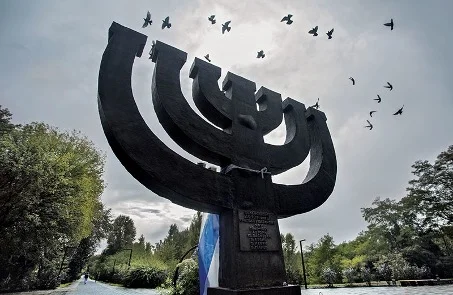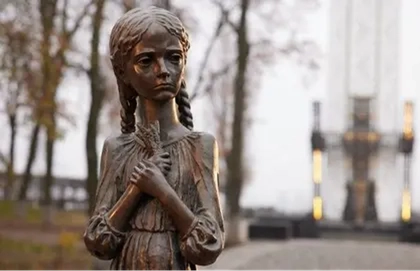Tangible reminders of history are everywhere in Ukraine, in bustling city squares, outside drowsy villages, and sometimes even tucked in behind gas stations. Statues, murals, columns, cenotaphs, obelisks, bas reliefs, busts, bronzes, and more. Some are massive, carved from tons of granite; others are discreetly minimalist plaques bearing only a QR code.
Unsurprisingly, many memorialize various giants of history or art, and as political trends have changed, so have the statues. The formerly ubiquitous revolutionary Lenin has long since been replaced by the now ever-present Ukrainian national poet Taras Shevchenko. Both wear greatcoats and sport facial hair, but their world views couldn’t be more different. It’s worth noting, too, that Shevchenko statues have been riddled by bullets in the areas the Russians have invaded.
JOIN US ON TELEGRAM
Follow our coverage of the war on the @Kyivpost_official.
Other Russian icons such as Pushkin and Empress Catherine the Great have of course fallen out of favor with Ukrainians for obvious reasons.
The majority of monuments strive for seriousness, but there are quirky examples to be found. Among my favorites is Odesa’s giant orange being pulled by a team of prancing horses. Then there’s the nearly 100-foot-tall (30 meters) statue of Bolshevik hero Artem flexing on the hills over the city of Svyatohirsk, looking like nothing so much as a gigantic white ‘Rock ’Em Sock ’Em Robot.’

German Opposition Slams Exclusion of Poland From Berlin Talks on Ukraine
There are remembrances of genocide as well, such as the eerily touching bronze in Kyiv of an emaciated, anxious-looking girl tightly clutching a few stalks of wheat to her chest, representing the children who starved to death during the Soviet-engineered Holodomor. Another tragedy largely ignored during the Communist era, the extermination of Jews and other despised minorities, has also been finally memorialized, most notably at Babyn Yar, where tens of thousands of people perished at the hands of the Nazis and their local collaborators.

The Menorah Monument dedicated to the 100,000 people, mostly Jews, murdered by occupying Nazi German soldiers at the Babyn Yar ravine in Kyiv.
In this masculine part of the world, men of course get most of the monuments, with women relegated to a few familiar archetypes. Ukraine’s Motherland statue is a towering metallic depiction of a 200-foot-tall (60 meters) warrior goddess holding aloft her sword and shield. Aside from victory, women are routinely used to personify tragedy, with the grieving mother embracing her dead son, fallen in service to the nation, being a perennial favorite.
For every memorial dedicated to a poet or political figure, there seem to be a dozen commemorating wars, most especially the Second World War or the Great Patriotic War as it was known in Soviet Republics. Stunningly, it’s estimated that as many as one in six Ukrainians died during the conflict. Almost invariably the artists’ chosen theme for these monuments is something extremely literal and propagandistic, lacking in any imagination: muscular men brandishing machine guns; archaic tanks or trucks mounted on a plinth; even statues of soldiers cast in some sort of gold metal suggesting they were more than simply humans, demigods of a sort.
The only exceptions to this artistic literalism are to be found in some of the monuments to the ugly Afghan War of 1979-1989, often referred to as the Soviet Union’s Vietnam. Along the wide river than runs through the city of Dnipro, there is a statue showing a small band of Soviet soldiers, emerging from what appears to be an explosion, carrying a dead or wounded comrade. The scene speaks of danger and urgency, with the men scanning their surroundings for the enemy. There is no superhuman heroism here, just men frantically trying to get out of the fight alive.
Odesa’s lovely seaside park has a statue which shows another unglamorous side of life during the Afghan War. Like a panel by American World War II combat cartoonist Bill Mauldin rendered in stone, a solider sits with his forearms on his knees, helmet-less, a grim look on his young face. Clearly he is drained, and his eyes suggest the bitterness of betrayal. Such statues would never have been commissioned immediately after World War II, when the state’s mandate was to show only strength, not weakness, and certainty not doubt. In the closing decade of the Soviet Union, officialdom began to make a little bit of room for different kinds of public displays.
Which raises the question of what forms memorials will take after Russia’s current war against Ukraine finally ends. Assuming a Ukrainian victory, will the country fall back on the tempting cliches of the past and erect manly depictions of heroism? Will naked nationalism be the dominant theme, or will a more nuanced art arise from the ruins of Mariupol and Bakhmut, one that recognizes not only triumph but also tragedy? Will there be space to commemorate the men and women who lost not only their lives and limbs, but also their minds? Might there even be artistic explorations of war’s more taboo topics, such as the use of sexual violence as a weapon? And could Ukraine even one day see the return of the names of the giants of the Russian language – Dostoevsky, Pushkin and Tolstoy?
The answer to these questions is, I suspect, maybe. Ukraine is not a monolithic place; it can be conservative but also cosmopolitan, practical but poetic, jingoistic but delightfully juvenile. Most of all it is a country that is fighting hard, and not just from Russian imperialism, but freedom in all its chaotic, confusing, controversial forms.
What monuments might we expect in postwar Russia? If, as seems probable, Moscow fails to absorb Ukraine and reshape it in its own image, then the likely answer is none at all. Removing uncomfortable truths, as was the practice in airbrushed Soviet photos, and Russians may continue to overlook this recent ugly chapter of their history, or at best pretend it was simply a bad dream. A dangerous and delusional stratagem, for as Leo Tolstoy, perhaps the greatest Russian writer, put it: “Every lie is a poison; there are no harmless lies”.
The views expressed in this opinion article are the author’s and not necessarily those of Kyiv Post.
You can also highlight the text and press Ctrl + Enter






